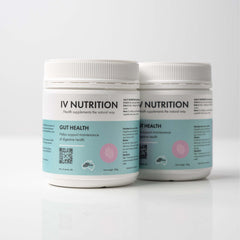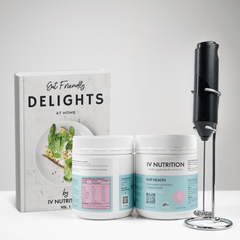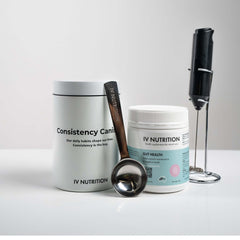Is My Acne Hormonal or Gut Related?
Acne is often dismissed as a simple skin condition, yet beneath the surface lies a complex interplay between hormones, gut health, and inflammation. While many people reach for topical treatments, the true causes of acne frequently begin inside the body.
For some, hormones are the primary culprit—fluctuations in androgens and insulin can drive oil production and clog pores. For others, an imbalanced gut microbiome triggers systemic inflammation that manifests on the skin.
If you’ve ever asked yourself “Is my acne hormonal or gut related?” the answer may be both. The skin is an external reflection of internal balance, and the gut and hormones are deeply intertwined.
This comprehensive, science-informed guide will help you understand:
-
How hormones and gut health influence acne.
-
How to recognise which may be the underlying cause for you.
-
What practical steps you can take to restore balance.
-
The role of prebiotic fibres, such as IV Nutrition’s Virgin Manufactured Sugarcane Prebiotic Fibre, in healing from within.
Understanding the Root Causes of Acne
Acne develops when pores become clogged with excess oil, dead skin cells, and bacteria. But the reasons this happens vary. While skincare and hygiene play a role, internal factors often drive persistent breakouts.
The two major internal drivers are:
-
Hormonal imbalance – linked to androgen activity, stress, or metabolic factors.
-
Gut imbalance (dysbiosis) – linked to microbial disruptions, inflammation, and poor digestion.
Let’s explore how each mechanism works—and how you can tell which might be affecting you.
Hormonal Acne: The Internal Oil Regulator
Hormonal acne is driven by fluctuations or imbalances in hormones such as androgens (testosterone and DHEA), estrogen, and insulin. These hormones regulate sebum (oil) production, skin cell turnover, and inflammation. When levels shift, pores can easily clog, creating the perfect environment for breakouts.
Common Triggers of Hormonal Acne
-
Puberty or adolescence.
-
Menstrual cycle fluctuations.
-
Polycystic Ovary Syndrome (PCOS).
-
Perimenopause or menopause.
-
Chronic stress (which raises cortisol).
-
Blood sugar imbalances or insulin resistance.
Typical Signs of Hormonal Acne
-
Breakouts around the jawline, chin, or lower cheeks.
-
Deep, painful cystic pimples rather than surface bumps.
-
Flare-ups before menstruation or during stress.
-
Oily skin with congested pores.
-
Acne that persists into adulthood, especially after age 25.
Hormonal acne is cyclical and often feels resistant to surface-level treatments because the trigger originates internally.
Gut-Related Acne: The Skin–Microbiome Connection
The gut houses trillions of bacteria that influence digestion, immunity, and inflammation. When these microbes are balanced, they help regulate everything from nutrient absorption to skin health.
But when dysbiosis (an imbalance between beneficial and harmful bacteria) occurs, it can lead to:
-
Increased intestinal permeability (“leaky gut”).
-
Systemic inflammation.
-
Overactive immune responses that target the skin.
-
Reduced elimination of waste and hormones.
This gut imbalance can easily show up as acne—especially when inflammation becomes chronic.
Signs Your Acne May Be Gut Related
-
Frequent bloating, constipation, or diarrhoea.
-
Food sensitivities or intolerances.
-
Acne that flares after eating certain foods.
-
Skin breakouts that coincide with digestive distress.
-
Red, inflamed acne rather than oily or cystic breakouts.
-
History of antibiotic or medication use.
Gut-related acne often stems from internal inflammation rather than excess oil. The breakouts can appear anywhere—face, chest, or back—and may coincide with fatigue, low mood, or poor immunity.
How Hormones and Gut Health Interact
The relationship between the gut and hormones is bidirectional. Poor gut health can worsen hormonal balance, and hormonal changes can alter the gut microbiome.
The Gut–Hormone Feedback Loop
-
The gut regulates estrogen through a collection of bacteria known as the estrobolome. When the gut is imbalanced, excess estrogen can recirculate in the body, worsening hormonal acne.
-
The gut influences cortisol, the stress hormone, through the gut–brain axis. Chronic stress disrupts microbial diversity and increases inflammation, fueling both gut and skin problems.
-
Insulin resistance, often driven by diet and gut inflammation, raises androgen levels, increasing oil production and breakouts.
In short, hormonal acne and gut-related acne aren’t separate—they often coexist, amplifying each other in a cycle of inflammation.
The Role of Inflammation in Both Types of Acne
Inflammation is the common denominator. Whether it begins with hormonal shifts or microbial imbalance, chronic inflammation disrupts the skin barrier and alters sebum composition.
When inflammation becomes systemic, the immune system overreacts to normal skin bacteria, turning minor congestion into inflamed pimples. This explains why addressing gut and hormone balance together often yields the best results.
How to Determine Whether Your Acne Is Hormonal or Gut Related
It’s rarely one or the other, but certain patterns can help you identify where to focus.
| Characteristic | Hormonal Acne | Gut-Related Acne |
|---|---|---|
| Location | Jawline, chin, neck | Cheeks, forehead, or widespread |
| Timing | Cyclical with periods or stress | Unrelated to cycle; triggered by diet |
| Type of Breakouts | Deep, cystic | Red, inflamed, or scattered |
| Other Symptoms | Irregular periods, oily skin, mood swings | Bloating, fatigue, irregular bowel habits |
| Triggers | Stress, hormonal changes, sugar spikes | Food sensitivities, antibiotics, poor diet |
| Underlying Cause | Androgen excess, cortisol imbalance | Dysbiosis, leaky gut, inflammation |
If your symptoms fall into both categories, that’s a strong indicator that hormones and gut health are interacting.
How to Address Hormonal Acne
1. Balance Blood Sugar
High-glycaemic diets spike insulin, which increases androgen levels and oil production. Stabilise blood sugar with balanced meals rich in fibre, protein, and healthy fats.
2. Manage Stress
Chronic stress elevates cortisol, worsening hormonal imbalance. Prioritise daily practices such as breathing exercises, walks, or meditation.
3. Support Hormone Metabolism
Liver and gut function play major roles in hormone detoxification. Increasing fibre intake aids in the excretion of excess hormones, reducing hormonal acne severity.
How to Address Gut-Related Acne
1. Increase Fibre Intake
A diet rich in fibre supports healthy microbial diversity and bowel regularity, ensuring toxins and excess hormones are excreted efficiently.
2. Add Prebiotics
Prebiotic fibres selectively feed beneficial bacteria, which restore balance, strengthen the gut barrier, and reduce systemic inflammation that contributes to acne.
3. Limit Processed Foods and Sugar
Processed foods promote harmful bacterial growth and inflammation. Removing them allows the gut microbiome to rebalance naturally.
4. Stay Hydrated
Water supports digestion, nutrient absorption, and waste removal—all critical for clear skin.
5. Use a Gentle Prebiotic Supplement
A clean, high-quality prebiotic fibre supplement can accelerate microbial recovery and enhance skin clarity.
Spotlight: IV Nutrition’s Virgin Manufactured Sugarcane Prebiotic Fibre
One of the most effective ways to restore gut balance and reduce skin inflammation is through prebiotic supplementation. IV Nutrition’s Virgin Manufactured Sugarcane Prebiotic Fibre stands out for its purity, effectiveness, and clinical relevance.
Why It’s Different
-
Virgin manufactured: Extracted directly from sugarcane, not industrial byproducts.
-
Highly fermentable: Optimised to feed beneficial microbes and increase short-chain fatty acid (SCFA) production.
-
Gentle and effective: Ideal for sensitive digestive systems.
-
Pure formulation: Free from unnecessary additives or artificial ingredients.
Benefits for Gut and Skin Health
-
Restores microbial diversity and strengthens the gut barrier.
-
Increases butyrate, reducing systemic inflammation and acne triggers.
-
Supports detoxification and hormone balance.
-
Improves bowel regularity, aiding in the elimination of waste and toxins.
-
Enhances skin clarity, texture, and resilience from within.
Special Offer: 100% OFF Your First Tub
You can try it risk-free with subscription:
Claim Your Free Tub Here
Adding this prebiotic fibre daily helps address one of the key root causes of acne—gut imbalance—while also indirectly supporting hormone stability.
How Gut Health Influences Hormonal Balance
Supporting your gut can also help regulate hormones naturally. Beneficial bacteria help metabolise estrogen and eliminate excess hormones through the digestive tract. When the gut is inflamed or sluggish, these hormones can recirculate, leading to breakouts and other hormonal symptoms.
By improving gut motility and microbial balance, prebiotic fibres indirectly support clearer skin and more stable hormonal cycles.
The Gut–Skin Axis: Why Healing the Gut Heals the Skin
The “gut–skin axis” describes the communication network between intestinal microbes and the skin’s immune system. When the gut is inflamed, the skin often reflects that internal stress through acne, rashes, or dullness.
By nourishing beneficial microbes with prebiotics, you calm systemic inflammation, improve nutrient absorption, and enhance the skin’s barrier from the inside out. Over time, this results in fewer breakouts and a healthier glow.
Additional Strategies for Clearer Skin
-
Eat a diverse diet: Rotate fruits, vegetables, and fibres to feed different bacterial strains.
-
Prioritise sleep: Rest allows the body to regulate hormones and repair tissue.
-
Exercise regularly: Movement supports circulation, lymphatic drainage, and hormone balance.
-
Avoid over-cleansing: Stripping the skin of natural oils can trigger rebound oil production.
-
Stay consistent: True skin transformation takes time—commit to at least 8–12 weeks of consistent care.
When to Seek Professional Guidance
If you’ve tried dietary and lifestyle changes without improvement, consider consulting a functional nutritionist or practitioner who specialises in hormonal and gut health. They can recommend targeted testing to identify imbalances and help tailor a comprehensive plan.
The Takeaway
So, is your acne hormonal or gut related? In many cases, it’s both. Hormonal fluctuations drive oil production and inflammation, while gut imbalances amplify immune responses that worsen breakouts.
By addressing both systems simultaneously—through blood sugar balance, stress management, and gut support—you can target the root causes of acne, not just the surface symptoms.
Among gut support tools, IV Nutrition’s Virgin Manufactured Sugarcane Prebiotic Fibre stands out for its clean formulation and clinically meaningful benefits. By nourishing beneficial bacteria and reducing inflammation, it creates the foundation for clear, resilient skin that reflects internal balance.
The journey to clearer skin begins not with harsher cleansers, but with a healthier gut—and the right daily nourishment to support it.





